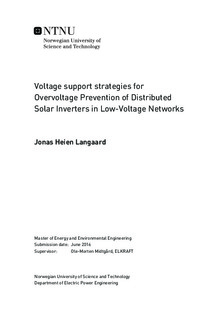Voltage support strategies for Overvoltage Prevention of Distributed Solar Inverters in Low-Voltage Networks
Master thesis
Permanent lenke
http://hdl.handle.net/11250/2407872Utgivelsesdato
2016Metadata
Vis full innførselSamlinger
- Institutt for elkraftteknikk [2468]
Sammendrag
The increasing penetration of distributed photovoltaic generation in low voltage distribution networks has led to higher risk of overvoltage. This has made it necessary to utilize the capability of the inverter in the photovoltaic systems to consume reactive power as voltage support. Different strategies have been developed in accordance with the voltage support capability of the inverter.The purpose of this thesis is to study different voltage support strategies used by photovoltaic system inverters and compare their ability to mitigate the overvoltage generated by high PV penetration in the LV distribution network. Reactive power efforts and losses in the network for the different inverter strategies are examined to find which is the most effective. How the different strategies affect the PV capacity of the network will also be emphasized during the evaluation of the effectiveness of the strategies.The IEEE European Low Voltage Test Feeder network is modelled in Simulink using the program GridBuilder , which is made by the author for this thesis. Photovoltaic generation is introduced to the loads in the network model with these voltage support strategies: Strategy 1: Constant power factor. Strategy 2: Power factor dependent on PV power production. Strategy 3: Reactive power consumption dependent on the voltage. Strategy 4: Power curtailment.Simulations of one day steady state operation with each strategy, using load profiles from IEEE for the loads and irradiance data from Oslo on the 4.mai 2016 for the PV systems, were performed. From the results it was found that strategy 1 and 2 utilized the most of the voltage support available through the photovoltaic systems in the grid. Strategy 2 and 3 had the least losses of all the strategies. Concluding with strategy 3 as the most efficient strategy for the case presented.
